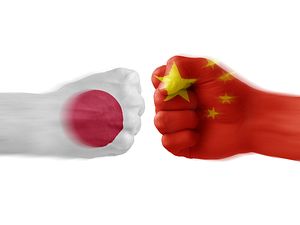This weekend’s ASEAN Regional Forum (ARF) in Myanmar represents one of the first real opportunities for Japan and China to communicate on a strategic level this year. Both countries seem to be sending mixed signals by negotiating and posturing at the same time – in fact, the two have been participating in joint naval drills off Japan while also continuing to confront each other in the East China Sea – but each seeks to negotiate from a position of strength. Asserting their preparedness and authority, particularly over disputed territory, could placate their nationalist bases while possibly allowing them to be more forthcoming in bilateral talks.
While the biggest piece of regional news earlier this week was Japan’s new defense white paper, which in large part singled out China as the main destabilizing factor in regional security, the two countries’ coast guards also managed to successfully participate in annual joint naval drills in Japanese waters. The drills, which also involve the U.S., Russia, South Korea and Canada, represent a rare opportunity for the two countries’ naval forces to cooperate with each other, more significantly (at least symbolically) off the shores of the capital, Tokyo.
However, despite the success of the drills, there was also a spike in confrontation in the East China Sea. On Wednesday three Chinese Coast Guard ships sailed within 12 nautical miles of the disputed Senkaku/Diaoyu Islands for roughly two hours. While the presence of Chinese ships near these islands is somewhat routine now, Wednesday also saw Japanese F-15’s shadowing Chinese patrol planes in the East China Sea, in what China’s Air Force spokesman called a routine patrol of China’s Air Defense Identification Zone.
In light of this mixed bag of encounters and government statements, which also saw Japanese Prime Minister Shinzo Abe call yet again for a bilateral meeting between himself and Chinese President Xi Jinping, the actions and statements of their two foreign ministers this weekend at the ASEAN forum will hopefully shed some light on their current bilateral intentions. Japanese government sources told Kyodo News that Foreign Minister Fumio Kishida plans to speak with his Chinese Foreign Minister Wang Yi (albeit informally), in addition to his American, North Korean and South Korean counterparts. On Tuesday Kishida stated “we would like to continue to implement our policy of maintaining a dialogue with China on a variety of levels,” while according to the government sources China is still reluctant to agree to the meeting, saying “the two sides have yet to create an environment for such talks.”
Kishida is also expected to repeat the now familiar refrain of calling for his counterpart’s help in arranging a possible Xi-Abe meeting later this year, and to seek China’s opinion on ways to improve bilateral relations. While China is maintaining its reluctance to publically agree to a high-level meeting of dignitaries, it has also so far ruled none of them out. Even though Japan appears to be the more interested party in a reconciliation of sorts, it has made none of the gestures China deems necessary for a return to more normal relations, such as a promise that Abe will not revisit Yasukuni Shrine, a new apology and reparations for the use of wartime “comfort women,” or the more problematic move of Japan abandoning its claim to the Senkaku/Diaoyu Islands.
As relations stand at this moment, both sides view this weekend’s potential meeting as a fishing expedition of sorts. As it would not be a formal meeting, each could be expected to be more candid and perhaps more open to the other’s suggestions. While this in and of itself is a long way from a general reconciliation, or even a meeting between Xi and Abe, this type of meeting between high-level officials is usually a prerequisite. The fact that their foreign ministers are considering talks should still be viewed with more skepticism than optimism, but the seeds of a later détente could indeed be planted.

































